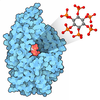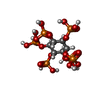[English] 日本語
 Yorodumi
Yorodumi- PDB-9d88: Gag CA-SP1 immature lattice from enveloped and perforated virus l... -
+ Open data
Open data
- Basic information
Basic information
| Entry | Database: PDB / ID: 9d88 | |||||||||
|---|---|---|---|---|---|---|---|---|---|---|
| Title | Gag CA-SP1 immature lattice from enveloped and perforated virus like particles | |||||||||
 Components Components | Gag polyprotein | |||||||||
 Keywords Keywords | VIRUS LIKE PARTICLE / HIV-1 / Gag / CA-SP1 / Inhibitor / virion assembly | |||||||||
| Function / homology |  Function and homology information Function and homology informationviral budding via host ESCRT complex / host multivesicular body / ISG15 antiviral mechanism / viral nucleocapsid / viral translational frameshifting / host cell nucleus / host cell plasma membrane / virion membrane / structural molecule activity / RNA binding ...viral budding via host ESCRT complex / host multivesicular body / ISG15 antiviral mechanism / viral nucleocapsid / viral translational frameshifting / host cell nucleus / host cell plasma membrane / virion membrane / structural molecule activity / RNA binding / zinc ion binding / membrane Similarity search - Function | |||||||||
| Biological species |   Human immunodeficiency virus type 1 Human immunodeficiency virus type 1 | |||||||||
| Method | ELECTRON MICROSCOPY / single particle reconstruction / cryo EM / Resolution: 3.18 Å | |||||||||
 Authors Authors | Wu, C. / Meuser, M.E. / Xiong, Y. | |||||||||
| Funding support |  United States, 2items United States, 2items
| |||||||||
 Citation Citation |  Journal: bioRxiv / Year: 2024 Journal: bioRxiv / Year: 2024Title: Structural insights into inhibitor mechanisms on immature HIV-1 Gag lattice revealed by high-resolution single-particle cryo-EM. Authors: Chunxiang Wu / Megan E Meuser / Juan S Rey / Hamed Meshkin / Rachel Yang / Swapnil Chandrakant Devarkar / Christian Freniere / Jiong Shi / Christopher Aiken / Juan R Perilla / Yong Xiong /  Abstract: HIV-1 inhibitors, such as Bevirimat (BVM) and Lenacapavir (LEN), block the production and maturation of infectious virions. However, their mechanisms remain unclear due to the absence of high- ...HIV-1 inhibitors, such as Bevirimat (BVM) and Lenacapavir (LEN), block the production and maturation of infectious virions. However, their mechanisms remain unclear due to the absence of high-resolution structures for BVM complexes and LEN's structural data being limited to the mature capsid. Utilizing perforated virus-like particles (VLPs) produced from mammalian cells, we developed an approach to determine cryo-electron microscopy (cryo-EM) structures of HIV-1 with inhibitors. This allowed for the first structural determination of the native immature HIV-1 particle with BVM and LEN bound inside the VLPs at high resolutions. Our findings offer a more accurate model of BVM engaging the Gag lattice and, importantly, demonstrate that LEN not only binds the mature capsid but also targets the immature lattice in a distinct manner. The binding of LEN induces a conformational change in the capsid protein (CA) region and alters the architecture of the Gag lattice, which may affect the maturation process. These insights expand our understanding of the inhibitory mechanisms of BVM and LEN on HIV-1 and provide valuable clues for the design of future inhibitors. | |||||||||
| History |
|
- Structure visualization
Structure visualization
| Structure viewer | Molecule:  Molmil Molmil Jmol/JSmol Jmol/JSmol |
|---|
- Downloads & links
Downloads & links
- Download
Download
| PDBx/mmCIF format |  9d88.cif.gz 9d88.cif.gz | 942.4 KB | Display |  PDBx/mmCIF format PDBx/mmCIF format |
|---|---|---|---|---|
| PDB format |  pdb9d88.ent.gz pdb9d88.ent.gz | 637.2 KB | Display |  PDB format PDB format |
| PDBx/mmJSON format |  9d88.json.gz 9d88.json.gz | Tree view |  PDBx/mmJSON format PDBx/mmJSON format | |
| Others |  Other downloads Other downloads |
-Validation report
| Summary document |  9d88_validation.pdf.gz 9d88_validation.pdf.gz | 1.7 MB | Display |  wwPDB validaton report wwPDB validaton report |
|---|---|---|---|---|
| Full document |  9d88_full_validation.pdf.gz 9d88_full_validation.pdf.gz | 1.8 MB | Display | |
| Data in XML |  9d88_validation.xml.gz 9d88_validation.xml.gz | 115 KB | Display | |
| Data in CIF |  9d88_validation.cif.gz 9d88_validation.cif.gz | 172.1 KB | Display | |
| Arichive directory |  https://data.pdbj.org/pub/pdb/validation_reports/d8/9d88 https://data.pdbj.org/pub/pdb/validation_reports/d8/9d88 ftp://data.pdbj.org/pub/pdb/validation_reports/d8/9d88 ftp://data.pdbj.org/pub/pdb/validation_reports/d8/9d88 | HTTPS FTP |
-Related structure data
| Related structure data |  46631MC 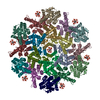 9cwvC 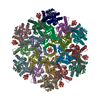 9d6cC  9d6dC 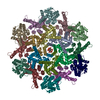 9d6eC  9dwdC M: map data used to model this data C: citing same article ( |
|---|---|
| Similar structure data | Similarity search - Function & homology  F&H Search F&H Search |
- Links
Links
- Assembly
Assembly
| Deposited unit | 
|
|---|---|
| 1 |
|
- Components
Components
| #1: Protein | Mass: 25339.037 Da / Num. of mol.: 18 / Fragment: CA-SP1 domains (UNP residues 143-372) / Mutation: L231I Source method: isolated from a genetically manipulated source Source: (gene. exp.)  Human immunodeficiency virus type 1 (NEW YORK-5 ISOLATE) Human immunodeficiency virus type 1 (NEW YORK-5 ISOLATE)Strain: Clone pNL4-3 / Gene: gag / Cell line (production host): Expi293F / Production host:  Homo sapiens (human) / References: UniProt: P12493 Homo sapiens (human) / References: UniProt: P12493#2: Chemical | ChemComp-IHP / | Has ligand of interest | Y | Has protein modification | Y | |
|---|
-Experimental details
-Experiment
| Experiment | Method: ELECTRON MICROSCOPY |
|---|---|
| EM experiment | Aggregation state: PARTICLE / 3D reconstruction method: single particle reconstruction |
- Sample preparation
Sample preparation
| Component | Name: Human immunodeficiency virus type 1 (NEW YORK-5 ISOLATE) Type: VIRUS Details: NL-MA/NC DNA was transfected into Expi293F (ThermoTisher) cells and cultured in suspension culture. The enveloped virion like particles were purified by filtration and ultracentrifugation, ...Details: NL-MA/NC DNA was transfected into Expi293F (ThermoTisher) cells and cultured in suspension culture. The enveloped virion like particles were purified by filtration and ultracentrifugation, and directly used as cryo-EM sample. Entity ID: #1 / Source: RECOMBINANT | ||||||||||||||||||||
|---|---|---|---|---|---|---|---|---|---|---|---|---|---|---|---|---|---|---|---|---|---|
| Source (natural) | Organism:  Human immunodeficiency virus type 1 (NEW YORK-5 ISOLATE) Human immunodeficiency virus type 1 (NEW YORK-5 ISOLATE)Strain: Clone pNL4-3 | ||||||||||||||||||||
| Source (recombinant) | Organism:  Homo sapiens (human) / Cell: Expi293F / Plasmid: NL-MA/NC Homo sapiens (human) / Cell: Expi293F / Plasmid: NL-MA/NC | ||||||||||||||||||||
| Details of virus | Empty: YES / Enveloped: YES / Isolate: STRAIN / Type: VIRUS-LIKE PARTICLE | ||||||||||||||||||||
| Natural host | Organism: Homo sapiens | ||||||||||||||||||||
| Virus shell | Name: Gag | ||||||||||||||||||||
| Buffer solution | pH: 7.4 Details: This is the final buffer in which the enveloped viral-like particle was resuspended. The Gag-CA-SP1 lattice is inside the virus-like particle and not directly in the buffer environment. | ||||||||||||||||||||
| Buffer component |
| ||||||||||||||||||||
| Specimen | Conc.: 2 mg/ml / Embedding applied: NO / Shadowing applied: NO / Staining applied: NO / Vitrification applied: YES Details: NL-MA/NC DNA was transfected into Expi293F (thermofisher) cells and cultured in suspension culture. The enveloped virion like particles were purified by filtration and ultracentrifugation, ...Details: NL-MA/NC DNA was transfected into Expi293F (thermofisher) cells and cultured in suspension culture. The enveloped virion like particles were purified by filtration and ultracentrifugation, and directly used as cryo-EM sample. | ||||||||||||||||||||
| Specimen support | Grid material: COPPER / Grid mesh size: 300 divisions/in. / Grid type: Quantifoil R2/1 | ||||||||||||||||||||
| Vitrification | Instrument: FEI VITROBOT MARK III / Cryogen name: ETHANE / Humidity: 100 % / Chamber temperature: 295 K |
- Electron microscopy imaging
Electron microscopy imaging
| Experimental equipment |  Model: Titan Krios / Image courtesy: FEI Company |
|---|---|
| Microscopy | Model: FEI TITAN KRIOS |
| Electron gun | Electron source:  FIELD EMISSION GUN / Accelerating voltage: 300 kV / Illumination mode: FLOOD BEAM FIELD EMISSION GUN / Accelerating voltage: 300 kV / Illumination mode: FLOOD BEAM |
| Electron lens | Mode: BRIGHT FIELD / Nominal magnification: 81000 X / Nominal defocus max: 2200 nm / Nominal defocus min: 1200 nm / Cs: 2.7 mm / C2 aperture diameter: 50 µm |
| Specimen holder | Cryogen: NITROGEN / Specimen holder model: FEI TITAN KRIOS AUTOGRID HOLDER |
| Image recording | Electron dose: 50 e/Å2 / Film or detector model: GATAN K3 BIOQUANTUM (6k x 4k) |
- Processing
Processing
| EM software | Name: PHENIX / Version: 1.21_5207 / Category: model refinement | ||||||||||||||||||||||||
|---|---|---|---|---|---|---|---|---|---|---|---|---|---|---|---|---|---|---|---|---|---|---|---|---|---|
| CTF correction | Type: PHASE FLIPPING AND AMPLITUDE CORRECTION | ||||||||||||||||||||||||
| Symmetry | Point symmetry: C6 (6 fold cyclic) | ||||||||||||||||||||||||
| 3D reconstruction | Resolution: 3.18 Å / Resolution method: FSC 0.143 CUT-OFF / Num. of particles: 205014 / Symmetry type: POINT | ||||||||||||||||||||||||
| Atomic model building | Protocol: RIGID BODY FIT / Space: REAL | ||||||||||||||||||||||||
| Atomic model building | PDB-ID: 9CWV Accession code: 9CWV / Source name: PDB / Type: experimental model | ||||||||||||||||||||||||
| Refinement | Cross valid method: NONE Stereochemistry target values: GeoStd + Monomer Library + CDL v1.2 | ||||||||||||||||||||||||
| Displacement parameters | Biso mean: 119.46 Å2 | ||||||||||||||||||||||||
| Refine LS restraints |
|
 Movie
Movie Controller
Controller







 PDBj
PDBj

